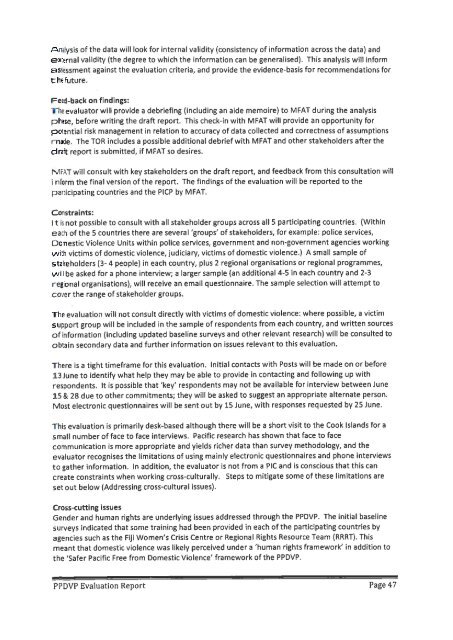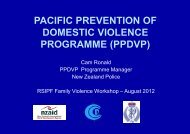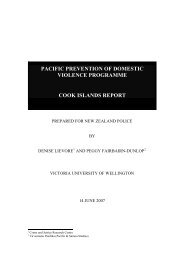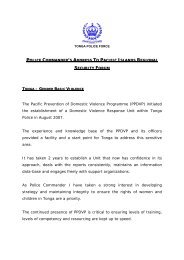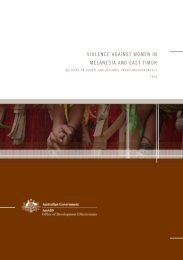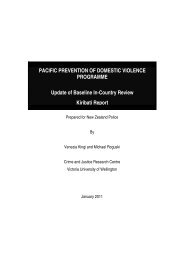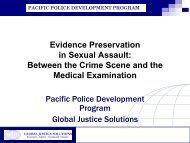PPDVP Evaluation Report - Pacific Prevention of Domestic Violence ...
PPDVP Evaluation Report - Pacific Prevention of Domestic Violence ...
PPDVP Evaluation Report - Pacific Prevention of Domestic Violence ...
Create successful ePaper yourself
Turn your PDF publications into a flip-book with our unique Google optimized e-Paper software.
Andysis <strong>of</strong> the data will look for internal validity (consistency <strong>of</strong> information across the data) andexternal validity (the degree to which the information can be generalised). This analysis will informaslessment against the evaluation criteria, and provide the evidence-basis for recommendations forthe future.Feed-back on findings:The evaluator will provide a debriefing (including an aide memoire) to MFAT during the analysisphase, before writing the draft report. This check-in with MFAT will provide an opportunity forpotential risk management in relation to accuracy <strong>of</strong> data collected and correctness <strong>of</strong> assumptionsmade. The TOR includes a possible additional debrief with MFAT and other stakeholders after thedraft report is submitted, if MFAT so desires.NlFAT will consult with key stakeholders on the draft report, and feedback from this consultation willi nform the final version <strong>of</strong> the report. The findings <strong>of</strong> the evaluation will be reported to theparticipating countries and the PlCP by MFAT.Constraints:It isnot possible to consult with all stakeholder groups across all 5 participating countries. (Withineach <strong>of</strong> the 5 countries there are several 'groups' <strong>of</strong> stakeholders, for example: police services,<strong>Domestic</strong> <strong>Violence</strong> Units within police services, government and non-government agencies workingwith victims <strong>of</strong> domestic violence, judiciary, victims <strong>of</strong> domestic violence,) A small sample <strong>of</strong>stakeholders (3- 4 people) in each countn/, plus 2 regional organisations or regional programmes,will be asked for a phone interview; a larger sample (an additional 4-5 in each country and 2-3regional organisations), will receive an email questionnaire. The sample selection will attempt tocover the range <strong>of</strong> stakeholder groups.The evaluation will not consult directly with victims <strong>of</strong> domestic violence: where possible, a victimsupport group will be included in the sample <strong>of</strong> respondents from each country, and written sources<strong>of</strong> information (including updated baseline surveys and other relevant research) will be consulted toobtain secondary data and further information on issues relevant to this evaluation.There is a tight timeframe for this evaluation. Initial contacts with Posts will be made on or before13 June to identify what help they may be able to provide in contacting and following up withrespondents. !t is possible that 'key' respondents may not be available for interview between June15 & 28 due to other commitments; they will be asked to suggest an appropriate alternate person.Most electronic questionnaires will be sent out by 15 June, with responses requested by 25 June.This evaluation is primarily desk-based although there will be a short visit to the Cook Islands for asmall number <strong>of</strong> face to face interviews. <strong>Pacific</strong> research has shown that face to facecommunication is more appropriate and yields richer data than survey methodology, and theevaluator recognises the limitations <strong>of</strong> using mainly electronic questionnaires and phone interviewsto gather information. In addition, the evaluator is not from a PIC and is conscious that this cancreate constraints when working cross-culturally. Steps to mitigate some <strong>of</strong> these limitations areset out below (Addressing cross-cultural issues).Cross-cutting issuesGender and human rights are underlying issues addressed through the PPOVP. The initial baselinesurveys indicated that some training had been provided in each <strong>of</strong> the participating countries byagencies such as the Fiji Women's Crisis Centre or Regional Rights Resource Team (RRRT). Thismeant that domestic violence was likely perceived under a 'human rights framework' in addition tothe 'Safer <strong>Pacific</strong> Free from <strong>Domestic</strong> <strong>Violence</strong>' framework <strong>of</strong> the <strong>PPDVP</strong>.<strong>PPDVP</strong> <strong>Evaluation</strong> <strong>Report</strong> Page 47


